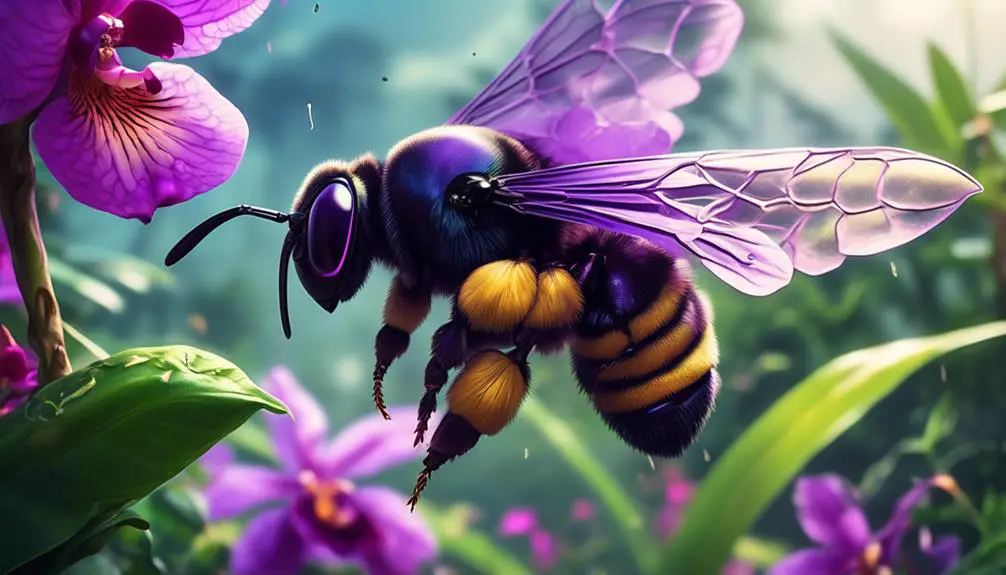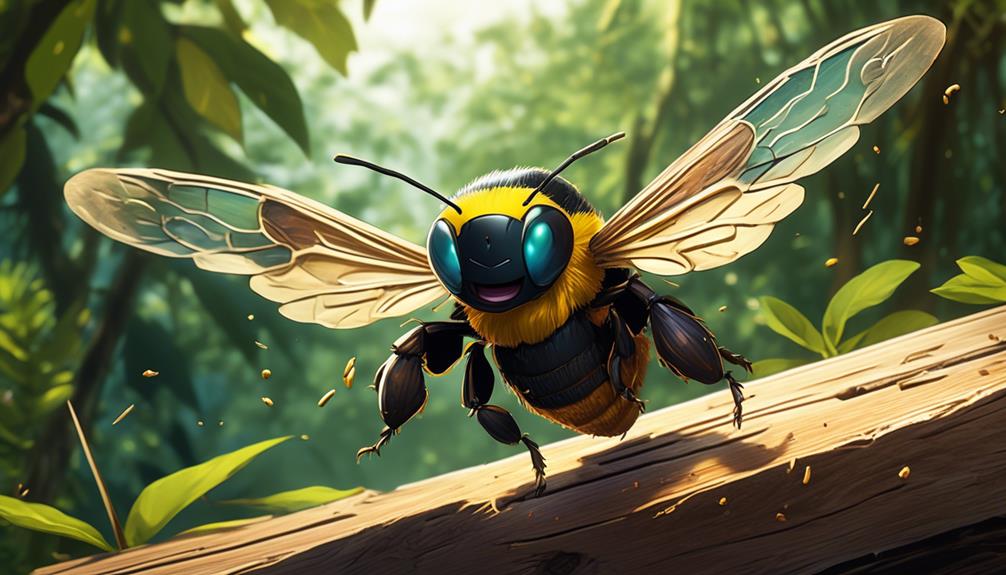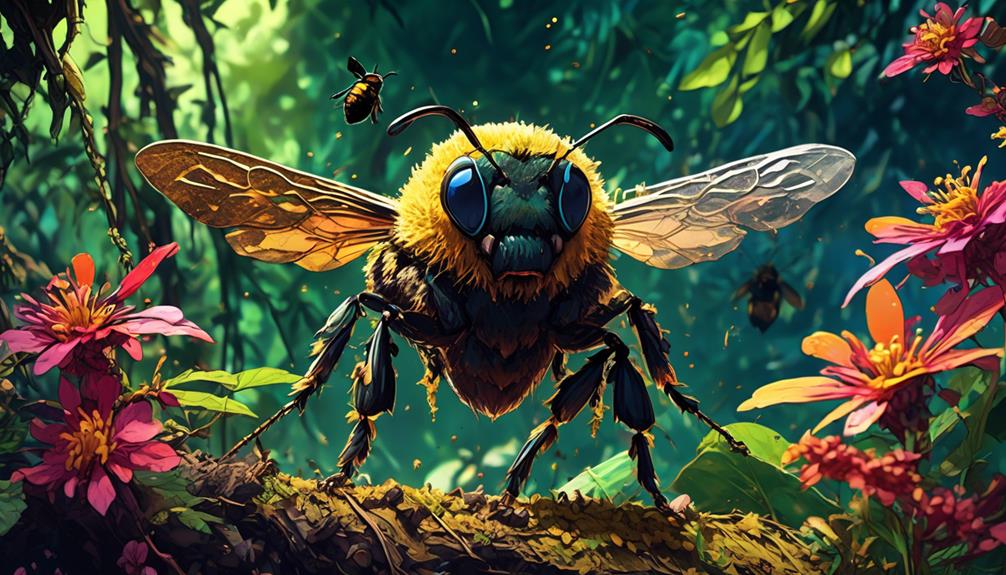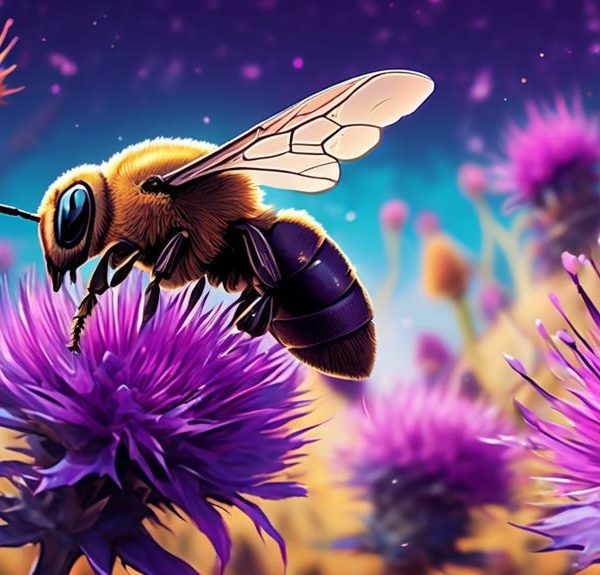Delve into the captivating world of Sri Lanka's carpenter bees and discover their vital role in maintaining the island's unique biodiversity.

Carpenter Bee Sri Lanka
You might think that carpenter bees in Sri Lanka are just another nuisance, but you'd be surprised at their importance in the ecosystem.
These fascinating creatures, known for their solitary nesting habits, play a significant role in pollinating the country's diverse plant life.
There's a lot more to these bees than meets the eye, from their unique biology to their intricate relationships with the flora and fauna around them.
But why should you care about the survival of these insects in the wilds of Sri Lanka? Well, stick around, and you'll find out why their existence is crucial for us all.
Key Takeaways
- Carpenter bees in Sri Lanka play a crucial role in pollinating the diverse plant life and aiding in the reproduction of native plant species.
- Their unique buzzing flight, known as 'buzz pollination', helps transfer pollen and contributes to the genetic diversity of native flora.
- Carpenter bees in Sri Lanka belong to the Xylocopa genus and are solitary creatures that construct their own nests by burrowing into wood.
- Habitat destruction, pesticide exposure, and climate change pose significant threats to the survival of carpenter bees in Sri Lanka, making sustainable practices essential for their conservation.
Understanding Carpenter Bees

To truly understand the unique nature of Carpenter Bees, you must delve into their fascinating biology, their intricate behavioral patterns, and their vital role in the ecosystem.
Carpenter Bees, scientifically known as Xylocopa, are a genus within the bee family that consists of over 500 species worldwide. You'd recognize them by their robust body, typically glossy and black, sometimes with metallic reflections.
Their biology is captivating. Unlike other bees, they're solitary, meaning each female is fertile and constructs her own nest. These nests aren't your typical beehives. Instead, they're burrowed into wood, hence their name 'Carpenter Bees'. They're not wood-eaters, though. They discard the wood or use it to make partitions for their nests.
Another interesting aspect is their pollination behavior. They're notorious for 'nectar robbing', where they cut into the side of a flower to reach nectar, bypassing the pollen. This doesn't mean they're not vital pollinators. In fact, they're essential for the pollination of several plant species.
Understanding these elements sheds light on the Carpenter Bee's unique place in our ecosystem, and your appreciation for them will undoubtedly grow.
Carpenter Bees in Sri Lanka

In the diverse landscapes of Sri Lanka, you'll find a remarkable variety of Carpenter Bees, playing an indispensable role in the island's ecosystem. These bees, belonging to the Xylocopa genus, are known for their unique nesting habits. They're not your typical hive-building bees; instead, they burrow into wood, creating intricate pathways that serve as their homes.
On your visit to Sri Lanka, you'll likely encounter two key species, Xylocopa tenuiscapa and Xylocopa tranquebarica, both of which are endemic to the island. These species have adapted to the various climatic conditions across the country, from the wet, lush rainforests to the hot, dry zones in the north.
As pollinators, Carpenter Bees aid in the reproduction of many of Sri Lanka's native plants. They're especially attracted to tubular flowers, using their long proboscises to access nectar while simultaneously transferring pollen. Their buzzing flight, known as 'buzz pollination', is a remarkable sight that emphasizes their significance in Sri Lanka's biodiversity.
Nesting Habits of Carpenter Bees

While observing these industrious insects in Sri Lanka's varied habitats, you'll find their unique nesting habits particularly intriguing. Unlike other bees, carpenter bees are solitary creatures. They don't live in hives; instead, they bore holes into wood to create their nests.
From dead trees to wooden structures, any source of soft or weathered wood is ideal for them. Using their powerful jaws, they carve out tunnels, with a precision that's almost uncanny. The entrance to the nest is a nearly perfect circle, about half an inch in diameter. Deeper inside, you'll find a series of brood chambers, each containing an egg, a supply of pollen, and nectar for the emerging larva.
Each female carpenter bee is both a worker and a queen. She builds and provisions the nest, lays her eggs, and seals the chambers. Male carpenter bees, on the other hand, have the sole role of mating and don't contribute to nest-building.
This nesting behavior isn't only a testament to the carpenter bee's solitary lifestyle but also demonstrates the species' remarkable adaptation skills, allowing them to thrive in Sri Lanka's diverse environments.
Carpenter Bees and Ecosystem Balance

You mightn't realize it, but carpenter bees play a crucial role in maintaining the ecological balance of Sri Lanka's diverse habitats. As efficient pollinators, they're vital for the health and reproduction of many native plant species. Without these bees, there'd be a significant decrease in the productivity of these plants, leading to a ripple effect throughout the ecosystem.
Carpenter bees' preference for native plants makes them particularly beneficial. They're not as easily lured away by exotic plants, unlike other pollinators. This preference helps preserve the native flora's genetic diversity, which is key to a resilient ecosystem.
Moreover, their nesting habits contribute to the recycling of dead wood and the aeration of soil, providing habitats for other insects and microorganisms. This contributes to nutrient cycling, another critical aspect of ecosystem health.
However, the growing use of pesticides and habitat destruction pose threats to the carpenter bee population. Therefore, it's essential to promote sustainable practices to ensure their survival. By doing so, you're not just protecting these bees; you're maintaining the balance of Sri Lanka's ecosystems. Every species has a role. And in the case of carpenter bees, it's a role that's indispensable.
Threats to Sri Lankan Carpenter Bees

Despite their indispensable role in the ecosystem, Sri Lankan carpenter bees are under serious threat from multiple fronts. You might be wondering, what's putting these crucial pollinators at risk? The answer lies in factors like habitat destruction, pesticide exposure, and climate change.
Firstly, let's tackle habitat destruction. You see, carpenter bees need dead wood or bamboo to nest and breed. When these habitats are destroyed for agriculture or logging, it leaves the bees homeless, jeopardizing their survival.
Secondly, there's the issue of pesticides. These chemicals, often used in agriculture, can have lethal effects on carpenter bees. They're indiscriminate killers, taking out beneficial insects along with pests. The bees, either directly exposed or consuming contaminated nectar and pollen, face a high risk of mortality.
Lastly, there's climate change. With rising temperatures, unpredictable weather patterns, and increased frequency of extreme weather events, the bees' habitats are becoming less hospitable. It's harder for them to find food and reproduce, threatening their populations.
Conclusion
In conclusion, you've explored the intriguing world of Sri Lankan carpenter bees. You've learned about their nesting habits, their vital role in maintaining ecosystem balance, and the threats they face.
Remember, these diligent pollinators are more than just buzzing insects; they're crucial members of our biodiversity. So, let's do our part to conserve them, because a world without carpenter bees would certainly be less colourful and healthy.



